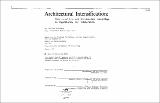Architectural intensification : patterns of use and construction assemblage as opportunity for elaboration
Author(s)
Treister, Charles
DownloadFull printable version (37.26Mb)
Other Contributors
Massachusetts Institute of Technology. Department of Architecture.
Advisor
Maurice Smith.
Terms of use
Metadata
Show full item recordAbstract
The loss of small scale elements and the lack of opportunity for personal elaboration has been an area of failure in contemporary buildings . These small scale elements are essential in providing human scale, enabling useful inhabitation, and giving a sense of place. This study attempts to define a design approach in which small scale elements and details will be an intrinsic outgrowth of the building process. The fulfillment of utilitarian conditions; use patterns, structure, and construction, form the basis of this approach rather than the application of some "decoration" to the basic form. This approach calls for the intensification of design decisions, based on utility and maintaining the integrity of earlier decisions. Built intensification serves as the optional aesthetic manner in which a utilitarian distinction is made. This theory of intensification is studied through a design of an infill system of interior elements to be used in multi-family housing. This system relies on standardized elements, shop fabricated, which can be custom assembled within each dwelling to meet the particular programmatic needs of the inhabitant. These elements, which would serve as storage, use surfaces and separation, would also be amenable to personal elaboration and rearrangement by the occupant at a later time. One typical dwelling unit, taken from the context of a larger housing project that I designed, serves as the area to be inhabited . There are four phases of the design process of this infill system. Each of the phases is illustrated through drawings and photographs of a model. The four phases of the design process are: 1) the primary structural zone; the catalogue of interior elements and their details; 3) the assemblage of these elements in the primary structure; and 4) the details, connections and further intensification of the assembled pieces.
Description
Thesis (M. Arch.)--Massachusetts Institute of Technology, Dept. of Architecture, 1981. MICROFICHE COPY AVAILABLE IN ARCHIVES AND ROTCH. Includes bibliographical references (leaf 75).
Date issued
1981Department
Massachusetts Institute of Technology. Department of ArchitecturePublisher
Massachusetts Institute of Technology
Keywords
Architecture.